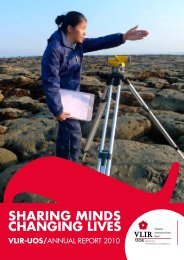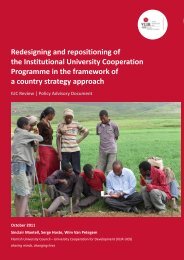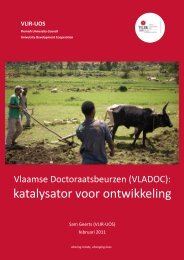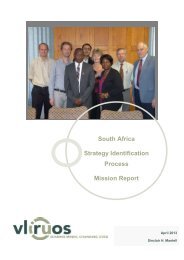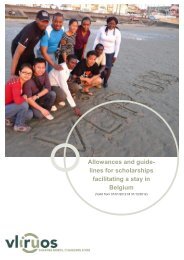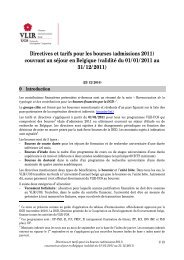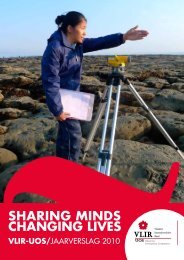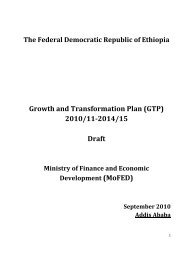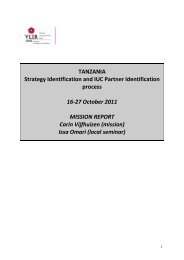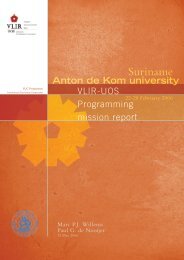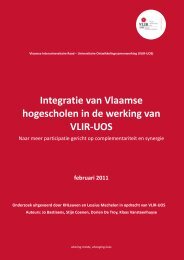Education Sector Development Program - VLIR-UOS
Education Sector Development Program - VLIR-UOS
Education Sector Development Program - VLIR-UOS
Create successful ePaper yourself
Turn your PDF publications into a flip-book with our unique Google optimized e-Paper software.
—<br />
CHAPTER<br />
6<br />
Major assumptions, risks and<br />
mitigation<br />
It is true to say that planning is intrinsically<br />
associated with uncertainty and risk, but<br />
planning becomes more realistic if it is able to<br />
identify risks and anticipate action, wherever<br />
possible, to mitigate anticipated risks which can<br />
be controlled by human beings.<br />
It is useful to make a distinction between internal<br />
and external risks. Internal risks are those<br />
which are internal to the education sector itself.<br />
They are thus much more under the control of<br />
planners and managers of the education sector<br />
than external risks which may arise outside of<br />
the education sector, and for which educational<br />
responses are inadequate. Within its specific<br />
history and cultural and social characteristics,<br />
each country has its own set of internal and<br />
external risks.<br />
Assumptions are directly related to risks. They<br />
represent specific situations which will be<br />
essential for the successful implementation of a<br />
large-scale educational intervention, such as an<br />
education development plan.<br />
Assumptions<br />
The following assumptions have been identified as<br />
particularly crucial for ESDP IV implementation:<br />
1. A peaceful and stable environment<br />
The development of education demands a<br />
peaceful and stable environment, so that children<br />
do not feel threatened going to school and that<br />
communities see investment in the education of<br />
their children as a source for future development.<br />
Ethiopia has gone through periods of internal<br />
and external unrest. However, several years<br />
of border stability and internal peace seem to<br />
indicate that the internal environment of Ethiopia<br />
has been stabilized and that peace is likely to be<br />
maintained in the near future.<br />
2. Continued economic growth<br />
Ethiopia’s economic activities have shown<br />
encouraging results since some fifteen years.<br />
Economic growth has been high in Ethiopia with<br />
real GDP growth in the order of 10% between<br />
2004/05 and 2008/2009. So far the world economic<br />
crisis has only slightly affected the economic<br />
growth of Ethiopia (2009/10 growth rate of 7%), but<br />
there is also a fear that the economic downturn<br />
in neighboring countries could further affect<br />
Ethiopia. In addition, the rather high inflation<br />
rates experienced over recent years could entail<br />
macro-economic imbalances which in turn could<br />
negatively affect continued economic growth.<br />
However, inflation has been lowered recently. On<br />
the whole, internal and external experts agree<br />
that Ethiopia stands a good chance to continue<br />
its swift economic development. The targeted<br />
GDP growth rate as indicated by MoFED (of an<br />
average of 10.4% over the ESDP IV period) may<br />
be achievable.<br />
3. Government commitment to choices<br />
made<br />
ESDP IV represents a coherent set of choices with<br />
new emphases, such as the commitment to quality<br />
and the focus on science and technology. Such<br />
choices need long term commitment and major<br />
investment maintained at least in the medium, if<br />
not long term before they can bear their desired<br />
effects and impact. The Government of Ethiopia<br />
has indeed an overarching development vision<br />
which indicates that it is strongly committed to<br />
them, not only in the education sector, but at the<br />
inter-sectoral level through its vision to become<br />
a middle-income country by 2025.<br />
4. Federal, regional and woreda offices are<br />
guided by a common vision<br />
Given the federal nature of the Ethiopian<br />
political system, regions and woredas are the<br />
main implementers of the general education<br />
component of ESDP IV. Indeed, regions receive<br />
their budgets directly from MoFED and they are<br />
free to allocate it within their own set of priorities<br />
to respond to their particular circumstances. In<br />
order to achieve a coherent implementation of<br />
ESDP IV, the federal level will work closely with<br />
the regions, to provide technical guidance for the<br />
preparation of the regional plans and to engage<br />
in joint operational planning and monitoring of<br />
ESDP IV implementation. Necessary mechanisms<br />
have been foreseen through the M&E design of<br />
ESDP IV.<br />
5. Continuous support of development<br />
partners<br />
Similar to the federal and decentralized<br />
government, it is expected that development<br />
partners remain committed to the priorities of<br />
ESDP IV once they have agreed to the overall plan<br />
106



